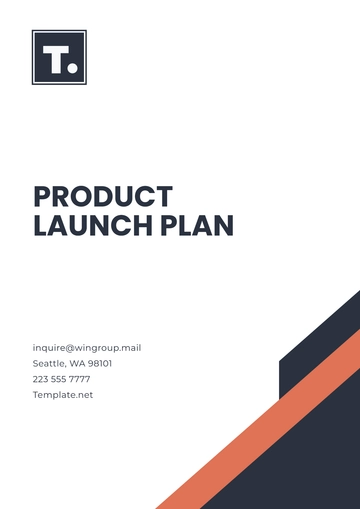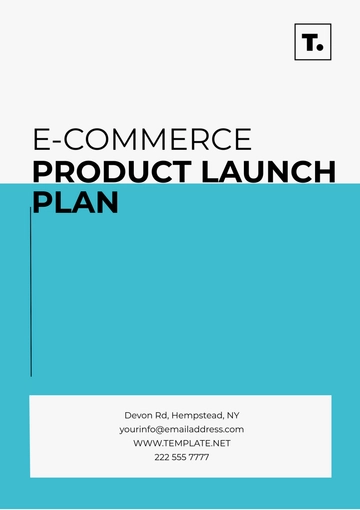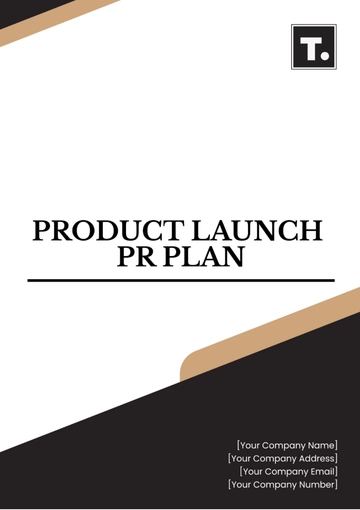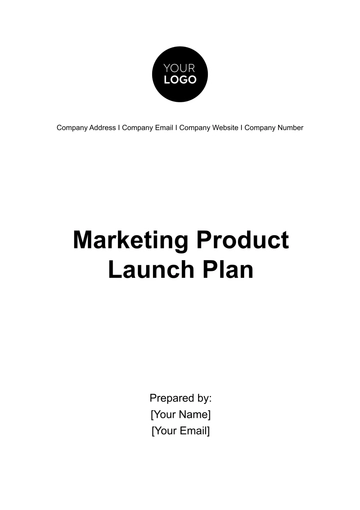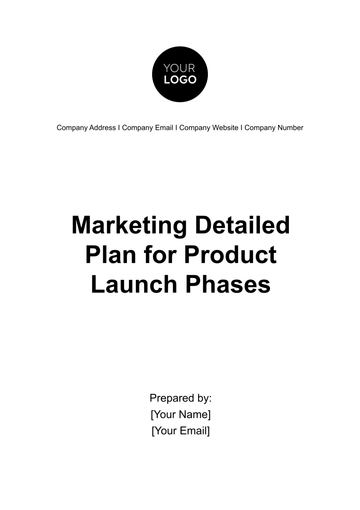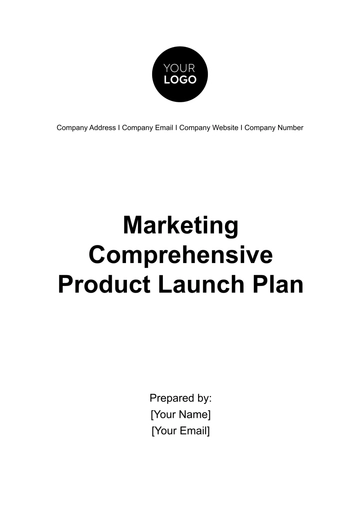Free Marketing Comprehensive Product Launch Plan

Launch Plan
Executive Summary
The [Your Company Name] product launch plan aims to introduce a cutting-edge wearable technology product into the market. These smart glasses offer a unique blend of augmented reality (AR) capabilities, hands-free functionality, and stylish design. Our goal is to create buzz, generate excitement, and drive sales through a well-executed product launch and ongoing promotional efforts.
I. Objectives
A. Product Launch Objectives
Create Awareness:
The primary objective of the product launch is to introduce [Your Company Name] to the market effectively. We aim to make potential customers aware of our product's existence and its unique features.
Pre-Order Goals:
To build anticipation and secure initial sales, we have set a pre-order target of 5,000 units before the official launch date. Achieving this goal will validate market interest and ensure a successful launch.
Media Placements:
We intend to secure at least 50 media placements in reputable tech and lifestyle publications. These placements will serve to generate buzz, increase brand visibility, and establish credibility.
Market Leadership:
Ultimately, our goal is to position GloTech as a leader in the augmented reality wearables market. This involves not only a successful launch but also long-term growth and product development.
B. Long-Term Objectives
Sustained Growth:
Beyond the launch, we aim to maintain a steady monthly sales growth rate of 15%. This will help us capitalize on the initial interest generated during the launch phase.
Feedback and Improvement:
We plan to gather user feedback and actively implement product improvements within six months of launch. This demonstrates our commitment to customer satisfaction and product refinement.
Product Expansion:
Within one year, we intend to expand the product line by adding new features and variations. This strategy will keep our offerings fresh and appeal to a broader customer base.
II. Target Audience
Understanding our target audience is essential. Our primary audience consists of tech-savvy consumers between the ages of 25 and 45. These individuals are early adopters of technology and often professionals in fields like engineering, design, and healthcare. By knowing our audience, we can tailor our marketing efforts to resonate with their needs and preferences.
III. Product Positioning
[Your Company Name] will be positioned as a unique blend of fashion-forward design and cutting-edge technology. These glasses aren't just a tech gadget; they're a fashion statement and a tool for enhancing both work and leisure activities. By emphasizing this positioning, we aim to stand out in a crowded market.
IV. Marketing Strategies
A. Pre-Launch Phase (3 Months Prior to Launch)
Market Research:
Thorough market research will enable us to make data-driven decisions regarding product design and features, ensuring that [Your Company Name] meet customer expectations.
Product Development:
Finalizing the product design and creating functional prototypes are crucial steps. Providing early reviewers and influencers with prototypes allows them to experience the product's unique capabilities firsthand.
Building Hype:
Creating teaser content and a pre-launch waiting list is vital for building anticipation. Generating buzz early on can lead to a strong initial response when pre-orders open.
Early Reviewers and Influencers:
Collaborating with key tech influencers and bloggers ensures that the product receives positive reviews and widespread coverage before the official launch.
B. Launch Phase (1 Month Prior to Launch)
Official Announcement: The official product launch announcement includes a compelling video and a virtual launch event. Offering exclusive pre-order discounts encourages early sales.
Media Outreach:
Distributing press releases and arranging interviews with journalists ensures that our product gets ample media coverage, enhancing its visibility and credibility.
Digital Marketing:
Launching targeted online ad campaigns on social media and search engines helps us reach our target audience effectively. Email marketing campaigns keep potential customers engaged.
C. Post-Launch Phase (Ongoing)
Customer Engagement:
Maintaining an open channel for customer feedback and providing top-notch customer support is essential for building long-term loyalty and trust.
Content Marketing:
Consistently producing valuable content, such as blog posts, videos, and tutorials, helps us showcase the product's capabilities and maintain our online presence.
Partnerships:
Exploring partnerships with AR app developers and fashion brands expands the product's functionality and appeal, opening up new avenues for growth.
V. Budget
The budget for the [Your Company Name] product launch is $2 million. This allocation will be distributed across various marketing activities and phases to ensure a well-rounded and effective launch campaign. The detailed breakdown of the budget is as follows:
Phase | Budget Allocation (in USD) |
A. Pre-Launch Phase | $600,000 |
| $100,000 |
| $200,000 |
| $150,000 |
| $150,000 |
B. Launch Phase | $800,000 |
| $250,000 |
| $200,000 |
| $250,000 |
| $100,000 |
C. Post-Launch Phase | $600,000 |
| $100,000 |
| $200,000 |
| $200,000 |
D. Contingency and Unforeseen Expenses | $200,000 |
Total Budget | $2,000,000 |
VI. Measurement and KPIs
A. Key Performance Indicators (KPIs):
The success of the [Your Company Name] product launch will be measured using the following KPIs:
Pre-order Conversion Rate:
This metric measures the percentage of website visitors who pre-order the product. We aim for a conversion rate of at least 10% during the pre-launch phase.
Media Coverage and Mentions:
Tracking the number of media placements and mentions in tech and lifestyle publications will help us gauge the reach and impact of our PR efforts. The goal is to secure a minimum of 50 media placements.
Website Traffic and Engagement:
Monitoring website traffic, including unique visitors and page views, as well as user engagement metrics like time spent on the site and bounce rate, will provide insights into the effectiveness of our online marketing campaigns.
Social Media Engagement and Growth:
Tracking social media engagement metrics such as likes, shares, comments, and follower growth will measure the level of community engagement and brand awareness.
Customer Feedback and Satisfaction:
Gathering and analyzing customer feedback through surveys and reviews will help us understand user satisfaction levels and identify areas for improvement. Our goal is to maintain a customer satisfaction rating of at least 85%.
These KPIs will be continuously monitored and analyzed throughout the launch and post-launch phases, allowing us to make data-driven adjustments to our marketing strategies as needed.
VII. Timeline
A. Product Launch Timeline
A well-structured timeline is essential to ensure the successful execution of the product launch plan. Below is a summarized timeline, highlighting key activities and milestones:
Phase | Duration | Key Milestones |
Pre-Launch Phase | 3 months | Market research, product design finalization, teaser content creation, influencer engagement. |
Launch Phase | 1 month | Official product announcement, virtual launch event, media outreach, pre-order campaign launch. |
Post-Launch Phase | Ongoing | Continuous customer engagement, content creation, partnership development, and product improvement. |
A more detailed timeline will be created within the marketing team, breaking down these phases into specific tasks, deadlines, and responsible team members.
VIII. Team
Our marketing team comprises dedicated professionals with defined roles and responsibilities to ensure the successful execution of the product launch plan:
Product Manager:
Oversees product development and coordinates with the development team to ensure features align with customer expectations.
Design Team:
Responsible for product design and creating promotional materials.
Content Creators:
Produce blog posts, videos, tutorials, and social media content to showcase the product's capabilities.
PR Specialists:
Manage media outreach, press releases, and journalist relationships.
Digital Marketing Specialists:
Execute online ad campaigns, email marketing, and social media engagement.
Customer Support Team:
Provides excellent customer service and gathers user feedback.
Partnership Manager:
Identifies and establishes partnerships with AR app developers and fashion brands.
IX. Risk Analysis
Identifying potential risks is crucial to mitigate potential issues that may affect the product launch. Key risks include:
Production Delays
In case of manufacturing delays, we have alternative suppliers ready to ensure product availability.
Negative Media Coverage
PR specialists are equipped to address negative press and work to turn the situation around through communication and transparency.
Technical Issues
A technical support team is on standby to address any product-related issues reported by customers.
Competitive Pressure
Continuous market monitoring will allow us to adjust our strategies to stay competitive.
Changing Market Conditions
Flexibility in marketing strategies will help us adapt to changing market dynamics.
Conclusion
This comprehensive marketing product launch plan for [Your Company Name] outlines a strategic approach to ensure a successful launch and long-term growth. By setting clear objectives, understanding our audience, and executing well-planned marketing strategies, we aim to position GloTech as a market leader in augmented reality wearables.
- 100% Customizable, free editor
- Access 1 Million+ Templates, photo’s & graphics
- Download or share as a template
- Click and replace photos, graphics, text, backgrounds
- Resize, crop, AI write & more
- Access advanced editor
Discover the Marketing Comprehensive Product Launch Plan Template by Template.net. Crafted for efficiency, this editable and customizable tool streamlines your product launch strategy. Seamlessly adapt plans to fit your brand's unique needs. Accessible in our Ai Editor Tool, it ensures precision and ease in executing your next product launch campaign.
You may also like
- Finance Plan
- Construction Plan
- Sales Plan
- Development Plan
- Career Plan
- Budget Plan
- HR Plan
- Education Plan
- Transition Plan
- Work Plan
- Training Plan
- Communication Plan
- Operation Plan
- Health And Safety Plan
- Strategy Plan
- Professional Development Plan
- Advertising Plan
- Risk Management Plan
- Restaurant Plan
- School Plan
- Nursing Home Patient Care Plan
- Nursing Care Plan
- Plan Event
- Startup Plan
- Social Media Plan
- Staffing Plan
- Annual Plan
- Content Plan
- Payment Plan
- Implementation Plan
- Hotel Plan
- Workout Plan
- Accounting Plan
- Campaign Plan
- Essay Plan
- 30 60 90 Day Plan
- Research Plan
- Recruitment Plan
- 90 Day Plan
- Quarterly Plan
- Emergency Plan
- 5 Year Plan
- Gym Plan
- Personal Plan
- IT and Software Plan
- Treatment Plan
- Real Estate Plan
- Law Firm Plan
- Healthcare Plan
- Improvement Plan
- Media Plan
- 5 Year Business Plan
- Learning Plan
- Marketing Campaign Plan
- Travel Agency Plan
- Cleaning Services Plan
- Interior Design Plan
- Performance Plan
- PR Plan
- Birth Plan
- Life Plan
- SEO Plan
- Disaster Recovery Plan
- Continuity Plan
- Launch Plan
- Legal Plan
- Behavior Plan
- Performance Improvement Plan
- Salon Plan
- Security Plan
- Security Management Plan
- Employee Development Plan
- Quality Plan
- Service Improvement Plan
- Growth Plan
- Incident Response Plan
- Basketball Plan
- Emergency Action Plan
- Product Launch Plan
- Spa Plan
- Employee Training Plan
- Data Analysis Plan
- Employee Action Plan
- Territory Plan
- Audit Plan
- Classroom Plan
- Activity Plan
- Parenting Plan
- Care Plan
- Project Execution Plan
- Exercise Plan
- Internship Plan
- Software Development Plan
- Continuous Improvement Plan
- Leave Plan
- 90 Day Sales Plan
- Advertising Agency Plan
- Employee Transition Plan
- Smart Action Plan
- Workplace Safety Plan
- Behavior Change Plan
- Contingency Plan
- Continuity of Operations Plan
- Health Plan
- Quality Control Plan
- Self Plan
- Sports Development Plan
- Change Management Plan
- Ecommerce Plan
- Personal Financial Plan
- Process Improvement Plan
- 30-60-90 Day Sales Plan
- Crisis Management Plan
- Engagement Plan
- Execution Plan
- Pandemic Plan
- Quality Assurance Plan
- Service Continuity Plan
- Agile Project Plan
- Fundraising Plan
- Job Transition Plan
- Asset Maintenance Plan
- Maintenance Plan
- Software Test Plan
- Staff Training and Development Plan
- 3 Year Plan
- Brand Activation Plan
- Release Plan
- Resource Plan
- Risk Mitigation Plan
- Teacher Plan
- 30 60 90 Day Plan for New Manager
- Food Safety Plan
- Food Truck Plan
- Hiring Plan
- Quality Management Plan
- Wellness Plan
- Behavior Intervention Plan
- Bonus Plan
- Investment Plan
- Maternity Leave Plan
- Pandemic Response Plan
- Succession Planning
- Coaching Plan
- Configuration Management Plan
- Remote Work Plan
- Self Care Plan
- Teaching Plan
- 100-Day Plan
- HACCP Plan
- Student Plan
- Sustainability Plan
- 30 60 90 Day Plan for Interview
- Access Plan
- Site Specific Safety Plan
